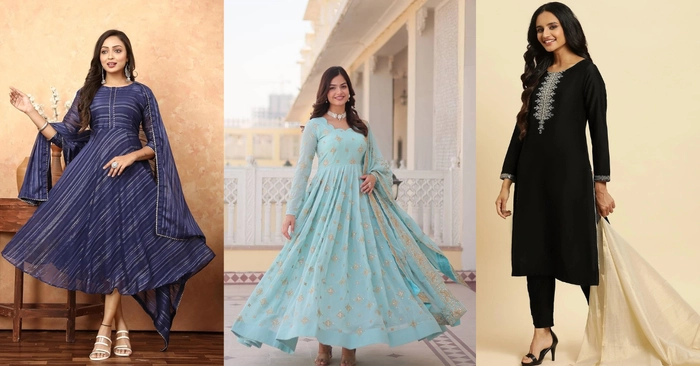Ethnic wear has always been part of the Indian fashion industry and is known for stunning designs alongside cultural roots. Zari work is one of the many traditional crafts, and it is known as a timeless art that brings grace and splendor to gowns. Salwar suits, lehengas, sarees, and Zari work ethnic clothing complement India’s zestful tradition while adding elegance to contemporary fashion.
The History of Zari Work
Zari work starts its history in ancient Persia, where craftsmen embroidered textiles using gold and silver threads intricately. This craft reached India during the Mughal period, and it thrived under the aegis of kings and governors. “Zari” is taken from the Persian word zar, which means gold and is known for its wealth and prestige. Zari work richly decorated the clothing of emperors and empresses, portraying India's supreme esteem and aristocracy.
With time, Indian artisans improved the work by adding some new regional techniques like Zardozi from Lucknow. Varanasi also has Benarasi Zari. These changes not only sustained the art but elevated it as an Indian culture sign. Ethnic wear with Zari work is still one of the most loved and glamorous pieces of art in India.
The Craftsmanship Behind Zari Work
Every form of art requires a significant amount of skill and attention to detail, and Zari work is no exception. Artisans sew shiny gold or silver threads into silk, cotton, or velvet fabrics, making Zari work one of the most exquisite art forms. One of the techniques, couching, involves laying out metallic threads on top of the fabric and sewing them using a contrasting color. Such techniques allow for intricate designs like floral or geometric patterns.
There are now easier alternatives to Zari work due to the creation of synthetic metallic threads, though it does maintain its aesthetic feel. With the rise of these “modern” techniques, the beauty captured in handwoven Zari embroidery will always remain unmatched.
Types of Zari Work
Zari work is not limited to lavish outfits; it can be used on an array of styles, making it a versatile art form. Some well-known types are:
1. Zardozi
Zardozi is a type of intricate embroidery that blends metallic threads with embellishments such as beads and sequins. Zardozi is often used for bridal wear and festive attire.
2. Gota Patti
This technique involves sewing shiny ribbons onto fabric in intricate patterns. Gota Patti is commonly seen in sarees and kurtas, adding a touch of shimmer.
3. Kaamdani
Kaamdani features tiny metal threads aligned in such a way that they form delicate lace-like patterns, which are more suitable for lighter ethnic wear.
4. Badla
This type is characterized by the use of smoothened metal strips integrated into the fabric, typically found in sarees and dupattas.
These regional differences continue to highlight variations in Zari work and its luxurious appeal.
Why Choose Zari Work Ethnic Wear?
Wearing Zari work ethnic wear is more than just donning apparel; it reflects one's roots and sophistication. Here is why it stands out:
-
Enduring Charm: Exquisite metallic threads sewn into pieces bestow a royal and timeless look.
-
Adaptability: From lavish weddings to joyous festival celebrations, Zari work ethnic wear caters to all events.
-
Cultural Value: Putting on Zari embroidery allows one to embrace the rich heritage of India.
-
Artistry: Each piece showcases the hard work and creativity of master artisans who have perfected this time-honored craft.
Styling Tips For Zari Work Ethnic Wear
To make the best out of your Zari-embellished outfit, sleek these styling tips:
-
Heavily Zari embroidered pieces must be paired with light accessories to draw eyes to the garment.
-
Metallic or neutral-colored shoes that match the shimmer of the threads are ideal.
-
Gentle makeup works best to bring balance to the extravagance of your outfit.
-
Showcase hairstyles that emphasize the detailed features of your outfit.
Whether it’s a festival celebration or a wedding event, these tips will help you maintain an effortlessly chic look.
Zari Work Sustainability Importance
Zari work, similar to any craft, must be approached with an eco-conscious mindset. Many artisans are now using sustainable materials and processes in their craftsmanship. At FabPotli, we strive for sustainable fashion by cutting down waste during production without compromising age-old techniques.
When consumers opt for Zari work ethnic wear mindfully, they help artisan communities and zero-waste fashion movements.
Final Thoughts
Zari work’s ethnic wear is crafted out of centuries worth of traditions, which makes this art form a unique and precious gem. The mesmerizing designs along with metallic threads make Indian culture stand out during any occasion while enhancing the value of Indian heritage.
Dedicated to providing comfort and elegance at once, FabPotli offers Zari-embroidered ethnic wear that features premium fabrics. Each piece is crafted to be sustainable, beautiful, and graceful. Explore our collection today to enhance your wardrobe with elegance that never fades.

